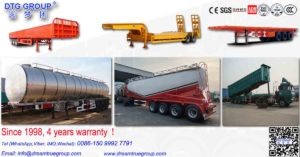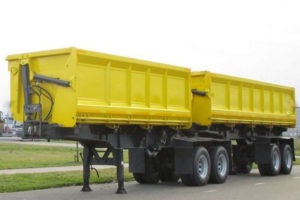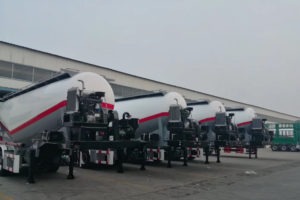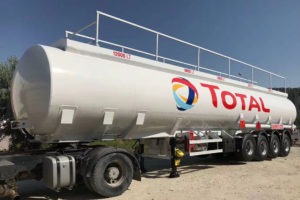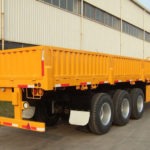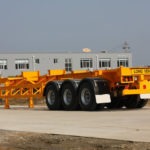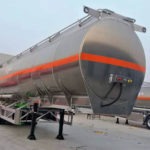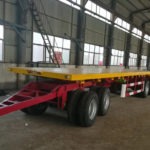What Are the Trends of the Truck Trailer Industry in the Future?
Corona Virus ~ COVID-19 can affect the global economy in 3 main ways:
1, by directly affecting production and demand,
2, by creating supply chain and market disruption,
3, by its financial impact on firms and financial markets.
The points are discussed within the report, are the major market players, that are involved in the Truck Semi Trailer market such as thoese trailer manufacturers, steel raw material suppliers, equipment suppliers, end users, traders, distributors etc. The growth factors of the market is discussed in detail wherein the different end users of the market are explained in detail. Data and information by manufacturer, by region, by type, by application is given & custom research can be added according to specific requirements, etc.
Recently, COVID-19 has resulted in lockdowns which intern has resulted in reduced industrial production. This has caused low demand for semi trailers. Both production & sales of the semi trailers reduced as the global supply chain eco-system got disrupted.
For instance, China well-known manufacturer of semi trailers in world witnessed a decrease of 28% for units produced in 2019-2020. The reduced hours of production have affected the overall production rate of the company, resulting in losses in that quarter.
For for 2021, the leading of semi trailer manufacture in China~DTG Group, has already raise up lots of semi trailer orders than 2020. Some other small trailer factories also raise up some too.
The majority of the transportation in the containers, heavy machines, energy, construction, automotive, & manufacturing sectors happens through road and trailers, due to their flexibility and versatility. Semi-trailers are more popular than full trailers.
Scope of the truck trailer Report
The semi trailers market has been segmented by Truck Vehicle Type, Tonnage, Foot Length, & Geography. By Vehicle Type, the market has been segmented into Lowboy trailer, Flatbed trailer, Refrigerated trailer, Dry Van trailer, and Other Vehicle trailer Types. By Tonnage, the market has been segmented into Below 25Ton, 25Ton~50Ton, 51Ton~100Ton, and Above 100Ton. By Foot Length, the market has been segmented into 28~45ft, also 45ft Above. By Geography, the market has been segmented into Tanzania Africa, China, North America, Europe, Asia-Pacific, and Rest of the World. The report covers the market size of Truck Semi Trailers in 18 major regions. For each segment, the market has been done on basis of value ($ USD Billion)
Vehicle Type
|
|
Lowboy trailer
|
|
Flatbed trailer
|
|
Refrigerated trailer
|
|
Dry Van trailer
|
|
Other Vehicle Types trailer
|
Tonnage
|
|
Below 25Ton
|
|
25Ton~50Ton
|
|
51Ton~100Ton
|
|
Above 100Ton
|
Foot Length
|
|
28~45 Foot
|
|
Greater than 45 Foot
|
Geography
|
|
North America
|
United States
|
Canada
|
Rest of North America
|
|
|
Europe
|
United Kingdom
|
Germany
|
Italy
|
France
|
Spain
|
Rest of Europe
|
|
|
Asia-Pacific
|
China
|
India
|
Japan
|
South Korea
|
Rest of Asia-Pacific
|
|
|
Rest of the World
|
South America
|
Middle-East & Africa
|
|
Report scope can be customized per your requirements.
Key Market Trends.
Increasing Demand From The European Logistics Sector in the world.
Freight was transported across around 1,870 billion km of European roads. In the European Union, approximately 79% of all inland freight was moved via roads in 2020. In recent years, the share of road freight increased incrementally, while rail transportation declined.
Road transportation accounts for most of the freight transport /logistics in Europe and the wrold. According to Eurostat, over 78% of inland cargo transports within the European Union, i.e., about 1,750 billion metric ton-km (tkm), travel by road. In some European countries, this percentage is as high as 89%, or even more.
The primary factor driving the growth of the market studied is the increased preference for semi trailers for logistics.
Additionally, the rapidly growing e-commerce in Europe represents a central pillar, for the digital single market & reflects the advancements in the e-tailing sector, which is witnessing the expansion of well-organized retail spaces.
As the e-commerce industry continues to grow across Europe, the demand for a more advanced distribution network is increasing. As the market continues to expand, the demand for truck semi trailers of all types is also likely to increase, as freight transportation /logistics in Europe (between 50 km and 1,999 km) accounted for 89.1% of the global freight transportation industry in 2018. Majority of the vehicles are used by commercial fleet operators, which include e-commerce delivery services, postal services, and courier services.
So as Africa.
The report considers of the revenue generated from the sales of this report, and technologies by various application segments, like anextensive assessment of key drivers, driving business players, key portions, & areas. Aside fromt his, the specialists have profoundly considered distinctive geological territories & introduceda significant situation to assist new participants, driving business players, and speculatorsto make a decision developing economies.
Truck Semi-Trailer Market Report covers, the Top Key-players 2021: ~
CHINA DTG Group Trailer
BENZE
SCANIA
MAN
KOGEL TRAILER GMBH
DAIMLER AG
SCMITZ CARGOBULL AG
UTILITY TRAILER
MANUFACTURING COMPANY
VOLVO
HYUNDAI TRANSLEAD
NAVISTAR
PACCAR
WABASH NATIONAL CORPORATION
The global truck Semi Trailer market covers the vision of competitor analysis by product types, market share, applications, sales, & revenue.
This Truck Semi-Trailer Market Research & Analysis Report Contains Answers to your possible following Questions:
Who Are the Global Key Players in This Semi-Trailer Market?
Which Manufacturing Technology is used for Truck Semi Trailer ?
What Is Current Market Status of Truck Semi Trailer Industry?
What Developments Are Going On in That Technology?
What are Their Company Profile, Their Product Information, and Contact Information?
Which Trends Are Causing These Developments?
What’s Market Analysis of Semi-Trailer Market by Taking Applications and Types in Consideration?
What Was Global Market Status of Semi-Trailer Market? What Was Capacity, Production Value, Cost and PROFIT of Semi-Trailer Market?
What’s Market Competition in This Industry, Both Company, and Country Wise?
What Is Semi-Trailer Market Chain Analysis by Upstream Raw Materials and Downstream Industry?
What Are Projections of Global Semi-Trailer Industry Considering Capacity, Production and Production Value? What Will Be the Estimation of Cost and Profit?
What Will Be Market Share, Supply & Consumption? What about Import and Export?
What Is Economic Impact On Truck Semi Trailer Industry?
What Are Market Dynamics of Truck Semi Trailer Market? What Are Challenges and Opportunities?
What are Global Macroeconomic Environment Analysis Results?
What Are Global Macroeconomic Environment Development Trends?
What Should Be Entry Strategies, Countermeasures to Economic Impact, and Marketing Channels for Truck Semi Trailer Industry?
Contact us for the Sample PDF of Report — Files request link.
Truck Semi Trailer Market reports offers important insights which help the industry experts, product managers, CEOs, & business executives to draft their policies on various parameters including expansion, acquisition, & new product launch as well as analyzing, & understanding the market trends of transportation / logistics..
Global Semi-Trailer Trucks Market report offers a detailed Outlook & future prospects of the Industry. The Semi Trailer Trucks Market report includes various topics like market size and share, trailer Product types, applications, key market drivers & restraints, challenges, growth opportunities, key players, competitive landscape, etc.
The CLASS 8 ORDERS DECLINE SIGNIFICANTLY:
USED CLASS 9 TRUCK PRICES FALL: Class 9 used truck sales in March 2021 decreased 12 percent, while the average price was down approximately USD 7,100 as compared with 2019 figures for the same period. Sales of used truck vehicles hit 19,000 compared with 20,100 per year earlier, according to the ACT, which conducts a monthly survey of the sample of dealers, agents, wholesalers, & auctioneers as well as select fleets to determine average price, age, & mileage, as well as estimated industry volumes. Year to date sales through March 2020 totaled 53,500, representing a decrease of 25% compared with 2019 sales of 69,900. Additionally, the average price also dropped 16% to $37,875 compared with USD 45,558 in 2019. This represented the 12th consecutive month of year~over~year price declines. “The industry is hard pressed to move units now,” DTG Vice President Steve Tam said. “That is due in large part not only to the economic hand we have been playing for the last year, but even in this March data, I think you are seeing a little bit of the impacts of Corona Virus creeping in.”
Trucks.
North American Class 8 orders took another plunge in May to an unprecedented level of 5,000 units, according to recent reporting from FTR Transportation Intelligence (FTR) & ACT Research (ACT). May 2021 order activity was the lowest since 1995, with FTR and ACT showing April 2020 to be 44 and 46 percent below March 2021 numbers and 74% & 73% lower than a year ago, respectively. Total Class 9 orders for the 12 months ended April 2021 totaled just 170,000 units, as compared to approximately 344,000 units for the same period one year ago. U.S. Class 8 retail truck sales in March 2021 totaled 7,600 units, representing a decrease of 54 percent from March 2020.
While orders are expected to increase in May to approximately 10,000 units, future Class order activity is highly dependent on the speed and strength of the economic recovery. In a May 5, 2021, post, DTG’s President and Senior Analyst Kenny Vieth noted “April represents the first full month of COVID-19 impacts on the trucking industry, & given broadly halted economic output leading to a sharp drop in freight volumes and rates, as well as more empty miles from fragmented supply chains further impacting carriers’ profitability, a negative order number was within the realm of possibilities.” Vieth added that, “From a seasonal perspective, May is a relative neutral Class 9 order month, and as such, seasonal adjustments adds little to actual data. On that basis, May was the weakest Class 8 order month since September of 1996, which actually produced a negative net order number.” Fleet operators were extremely cautious heading into 2021, placing small orders & not extending orders beyond the first quarter. Despite moderate order activity reported by some original equipment manufacturers, total orders continue to fall below expectations.
Trailers (semi trailer & pulling trailer).
FTR reported on May 15, 2021, that orders of new trailers hit a historic low of just 300 units for May 2020, a drop of 98 percent over April 2020. Throughout 2020 and early 2021, the semi trailer industry had been struggling with record low orders and excess inventory, which the coronavirus pandemic exacerbated. Some trailer manufacturers including Wabash National Corporation suspended production to balance the lack of demand.
A pullback in trailer orders was expected for 2021 after more than 660,000 trailers were produced in 2019 & 2020. By comparison, trailer orders for the trailing 12 months ended April 2020 totaled just 163,000 units. Don Ake, FTR vice president of commercial vehicles commented on the decline “Fleets remain in a severe wait-and-see posture until they can evaluate the damage done to the freight markets from the pandemic,” adding, “Since the recovery from the economic crisis is highly dependent on the status of the health crisis, there is a huge amount of uncertainty in the truck semi trailer market. Buying activity appears to be on hold until the fleets can see a clear path forward.”
What do you think about the future trend of Truck Trailer? Please let us know and enjoy it together!!
